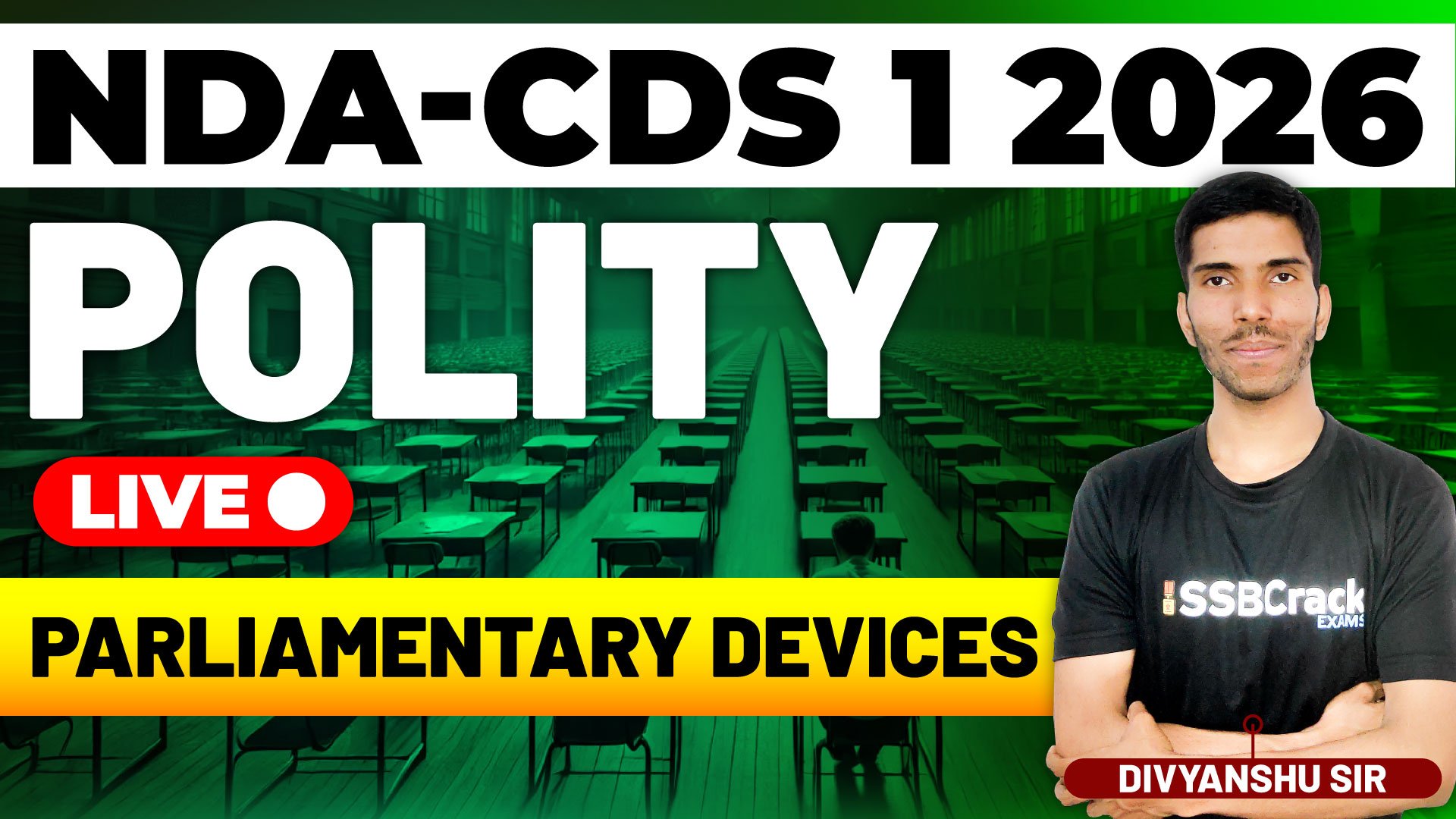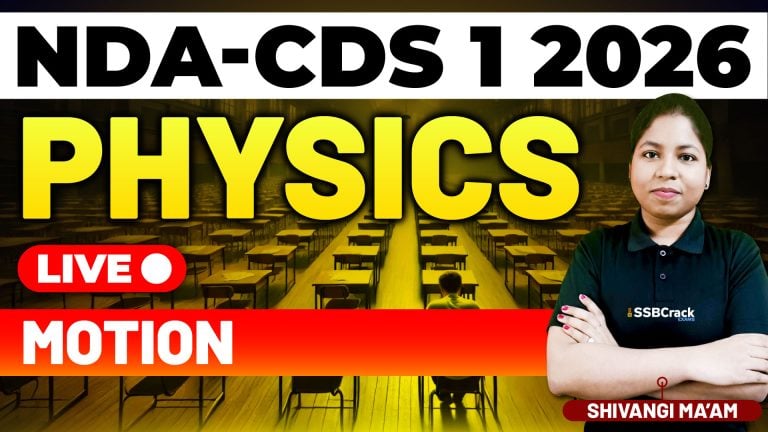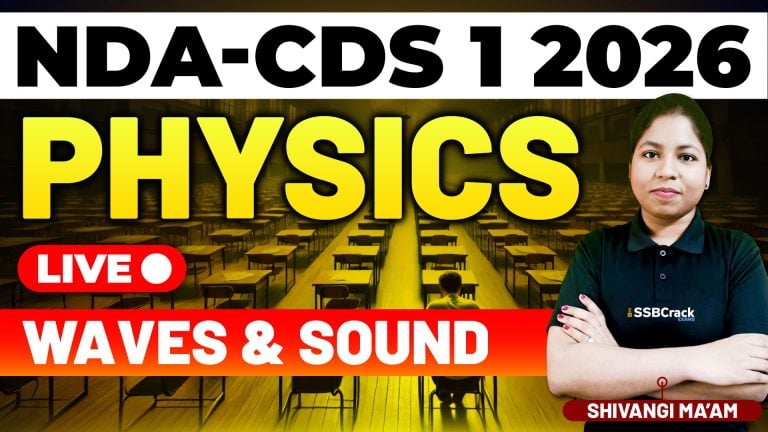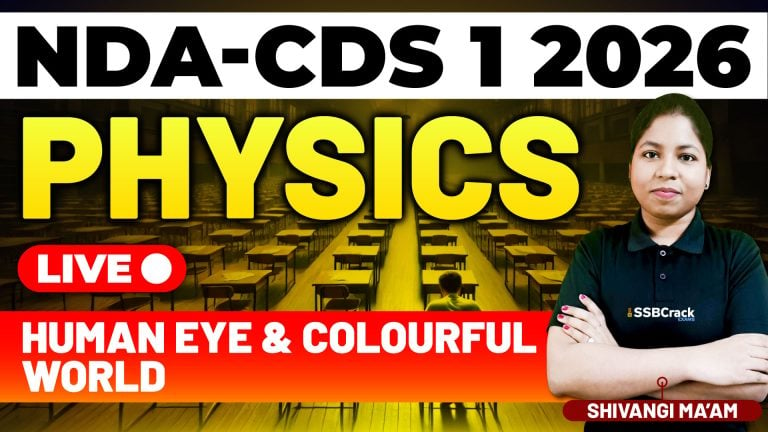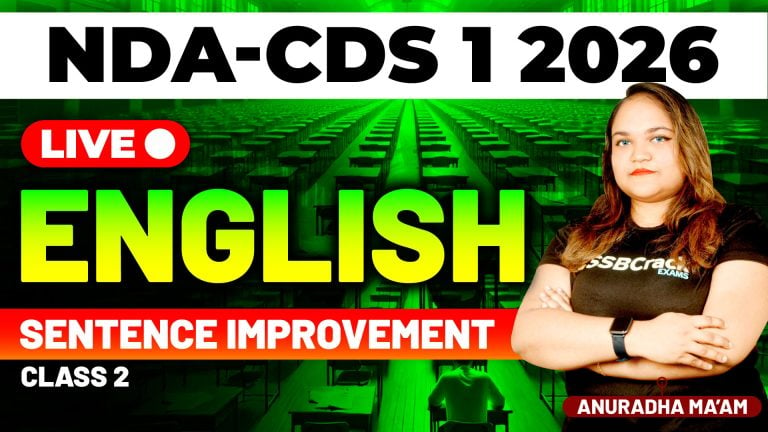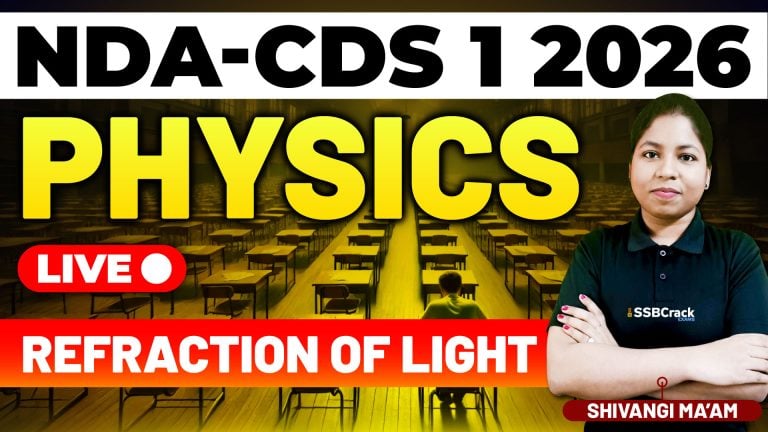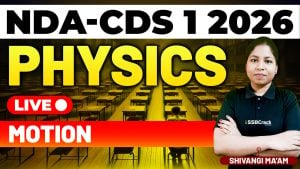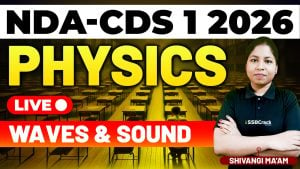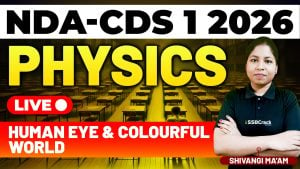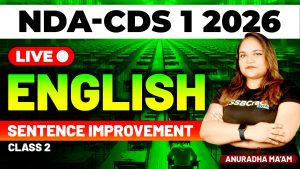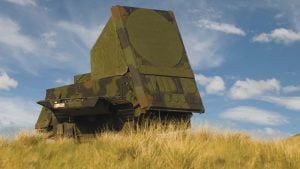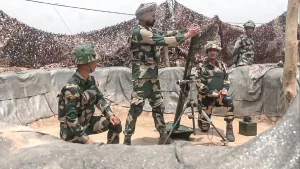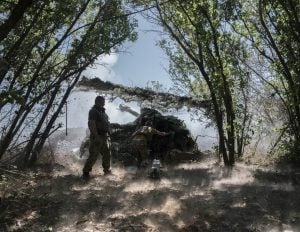In the Indian Parliamentary system, Parliamentary Devices are special tools or procedures used by Members of Parliament (MPs) to maintain accountability, transparency, and efficiency in the working of the legislature. These devices allow MPs to raise issues, seek information, and ensure that the executive remains answerable to the legislature.
Understanding these devices is crucial for NDA and CDS aspirants as questions are frequently asked from this topic in the Polity section.
NDA & CDS 1 2026 Exam Polity – Parliamentary Devices
Major Parliamentary Devices
1. Question Hour
- Time: First hour of every parliamentary sitting.
- Purpose: MPs ask questions to ministers to obtain information on public policies, administration, and governance.
- Types of Questions:
- Starred Question: Requires an oral answer; supplementary questions allowed.
- Unstarred Question: Written answer; no supplementary questions.
- Short Notice Question: Asked with less than 10 days’ notice on urgent public matters.
👉 Importance: It is a powerful tool for ensuring executive accountability.
2. Zero Hour
- Time: Immediately after Question Hour (no fixed duration).
- Purpose: MPs raise urgent matters without prior notice.
- Feature: Not officially mentioned in the Rules of Procedure, but has become a convention since the 1960s.
👉 Importance: Allows MPs to discuss pressing public issues instantly.
3. Adjournment Motion
- Purpose: To draw attention of the House to a recent matter of urgent public importance that causes serious concern.
- Effect: If admitted, it leads to the suspension of normal business of the House.
- Requires: Support of at least 50 members.
👉 Significance: Used to hold the government accountable for its actions or inactions.
4. Calling Attention Motion
- Introduced by: Lok Sabha member.
- Purpose: To call attention to an urgent matter of public importance and seek an explanation from the minister concerned.
- Introduced by: Then Speaker Hukam Singh in 1954.
👉 Note: It is a hybrid of question and adjournment motion.
5. Privilege Motion
- Purpose: Moved when a member feels that the privileges of the House or its members have been violated.
- Privilege Committee: Examines such motions.
👉 Example: Misreporting of parliamentary proceedings or denial of information can lead to such motions.
6. Censure Motion
- Purpose: To express strong disapproval or lack of confidence in the government’s policies or actions.
- Effect: If passed, the Council of Ministers must resign.
👉 Introduced only in Lok Sabha, as it holds the real power to make or unmake the government.
7. No-Confidence Motion
- Purpose: To test whether the government still enjoys the confidence of the House.
- If Passed: The entire Council of Ministers must resign collectively.
- Admitted by: Speaker of Lok Sabha only.
👉 Minimum support: 50 members required to move the motion.
8. Cut Motions
- Purpose: Used during discussion on demands for grants in the budget to reduce the amount of money sought by the government.
- Types of Cut Motions:
- Policy Cut: Disapproval of policy; amount reduced to ₹1.
- Economy Cut: Suggests economy in expenditure.
- Token Cut: Symbolic cut of ₹100 to express specific grievance.
👉 Significance: A key financial control device in Parliament.
9. Half-an-Hour Discussion
- Purpose: To discuss matters of sufficient public importance that need elaboration of facts or policy.
- Time Limit: Half an hour, usually at the end of the day’s sitting.
👉 Feature: Based on questions already answered.
10. Short Duration Discussion (Rule 193 in Lok Sabha)
- Purpose: To discuss important matters without formal motion or voting.
- Feature: Helps MPs express their views without seeking a formal resolution.
11. Point of Order
- Purpose: Raised to enforce the rules of procedure in the House.
- Condition: It must relate to the proceedings of the House; no debate allowed on it.
👉 Importance: Keeps parliamentary discipline intact.
12. Motion of Thanks
- Purpose: Moved after the President’s Address to both Houses.
- Significance: Allows MPs to discuss the government’s policies and performance.
- If defeated: It implies the government has lost the confidence of the House.
Conclusion
Parliamentary Devices form the core mechanisms of democratic accountability in India. They ensure that the executive remains answerable to the legislature and that governance remains transparent and responsive. For NDA & CDS aspirants, understanding these devices is vital as it strengthens their conceptual clarity of Indian Polity and Parliamentary functioning.
Quick Revision Table
| Device | Purpose | Effect |
|---|---|---|
| Question Hour | Obtain information | Accountability |
| Zero Hour | Raise urgent issues | Immediate discussion |
| Adjournment Motion | Discuss urgent public matter | Suspends business |
| Calling Attention | Seek explanation from Minister | Informational |
| Privilege Motion | Protect privileges | Disciplinary action |
| Censure Motion | Disapprove policy | Govt. must resign |
| No-Confidence Motion | Test majority | Govt. must resign |
| Cut Motion | Reduce budget demand | Financial control |
| Half-an-Hour Discussion | Clarify policy details | Informative |
| Short Duration Discussion | Discuss major issue | No voting |
| Point of Order | Enforce rules | Procedural clarity |
| Motion of Thanks | Discuss President’s Address | Govt. accountability |
1. The first hour of every sitting of Parliament is known as—
A. Zero Hour
B. Question Hour
C. Adjournment Hour
D. Public Hour
✅ Answer: B. Question Hour
Explanation: The first hour of every parliamentary sitting is reserved for Question Hour, during which MPs ask questions to ministers to obtain information and ensure accountability of the government.
2. Which of the following types of questions requires an oral answer in the Parliament?
A. Unstarred Question
B. Starred Question
C. Short Notice Question
D. Supplementary Question
✅ Answer: B. Starred Question
Explanation: A Starred Question requires an oral answer from the concerned minister, followed by supplementary questions for further clarification.
3. Zero Hour in the Parliament refers to—
A. The last hour of the sitting
B. The first hour of the sitting
C. The period immediately after Question Hour
D. The time reserved for budget discussions
✅ Answer: C. The period immediately after Question Hour
Explanation: Zero Hour is an informal session that starts after Question Hour, allowing MPs to raise urgent matters without prior notice.
4. Which Parliamentary device can lead to the suspension of normal business of the House?
A. Calling Attention Motion
B. Adjournment Motion
C. Privilege Motion
D. Cut Motion
✅ Answer: B. Adjournment Motion
Explanation: Adjournment Motion is used to draw attention to a matter of urgent public importance, suspending the normal business of the House for discussion.
5. The ‘Calling Attention Motion’ was introduced in the Indian Parliament by—
A. G.V. Mavalankar
B. Hukam Singh
C. Dr. B.R. Ambedkar
D. Jawaharlal Nehru
✅ Answer: B. Hukam Singh
Explanation: The Calling Attention Motion was first introduced in the Lok Sabha by Speaker Hukam Singh in 1954 to allow MPs to seek immediate explanations from ministers on urgent public issues.
6. If a No-Confidence Motion is passed in the Lok Sabha, the Council of Ministers—
A. May continue with approval of the President
B. Must resign collectively
C. Can dissolve the Parliament
D. May ask for a joint session of Parliament
✅ Answer: B. Must resign collectively
Explanation: Under Article 75(3) of the Constitution, the Council of Ministers is collectively responsible to the Lok Sabha. If the House passes a No-Confidence Motion, the entire Council must resign.
7. Which of the following cut motions signifies disapproval of the policy of the government?
A. Economy Cut
B. Token Cut
C. Policy Cut
D. Budget Cut
✅ Answer: C. Policy Cut
Explanation: A Policy Cut Motion reduces the demand for grant to ₹1 and expresses disapproval of the government’s policy in that area.
8. Which of the following is NOT a motion of financial control in Parliament?
A. Cut Motion
B. Vote on Account
C. Adjournment Motion
D. Demand for Grants
✅ Answer: C. Adjournment Motion
Explanation: Adjournment Motion deals with urgent public issues, not financial matters. The other three — Cut Motion, Vote on Account, and Demand for Grants — are financial control instruments.
9. A motion moved by a member to discuss a matter of urgent public importance without formal motion or voting is called—
A. Point of Order
B. Short Duration Discussion
C. Half-an-Hour Discussion
D. Zero Hour
✅ Answer: B. Short Duration Discussion
Explanation: Under Rule 193 in Lok Sabha, Short Duration Discussion allows members to discuss important issues without formal resolution or voting.
10. When the President’s Address is discussed in Parliament, which motion is moved by the members?
A. Privilege Motion
B. Motion of Thanks
C. Adjournment Motion
D. Censure Motion
✅ Answer: B. Motion of Thanks
Explanation: After the President’s Address at the beginning of a new session, both Houses discuss it through a Motion of Thanks, allowing MPs to review the government’s performance and policies.
📘 Quick Summary for Revision
| Device | Key Purpose | Exam Focus Point |
|---|---|---|
| Question Hour | Accountability | 1st hour of sitting |
| Zero Hour | Urgent public issues | No prior notice |
| Adjournment Motion | Urgent matter of national importance | Suspends business |
| Calling Attention Motion | Seek minister’s explanation | Introduced by Hukam Singh |
| No-Confidence Motion | Test majority support | Govt must resign if passed |
| Cut Motion | Reduce budget demand | Policy, Economy, Token types |
| Short Duration Discussion | Discuss important issue | Rule 193, no voting |
| Motion of Thanks | Discuss President’s Address | Govt accountability |
